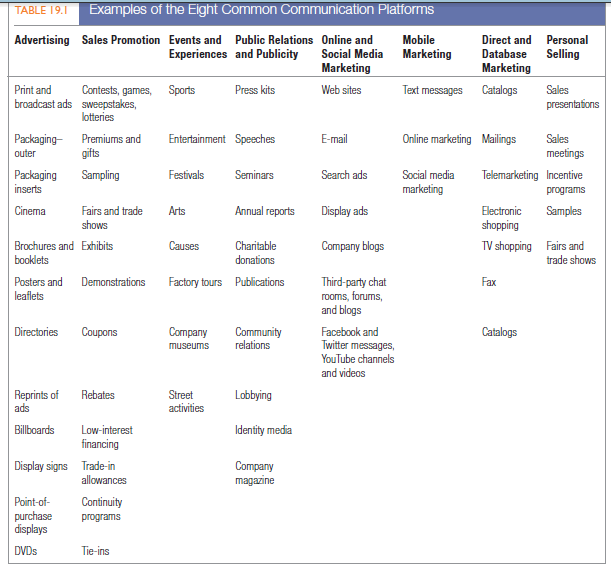In this new communication environment, although advertising is often a central element of a marketing communications program, it is usually not the only one—or even the most important one—for sales and building brand and customer equity. Mondelez International is partnering with nine digital start-ups to gain an advantage in that area, committing to spend 10 percent of its marketing budget on mobile.4 To engage its diverse audience, GE uses an in-house content marketing and social media team to play the role of “storyteller” and explain the company’s activities on a variety of online platforms.5
Ocean Spray—an agricultural cooperative of cranberry growers—has used a variety of communication vehicles to turn sales around.6
OCEAN SPRAY Facing stiff competition, adverse consumer trends, and nearly a decade of declining sales, Ocean Spray COO Ken Romanzi and Arnold Worldwide decided to reintroduce the cranberry as the “surprisingly versatile little fruit that supplies modern-day benefits,” through a true 360-degree campaign that used all facets of marketing communications to reach consumers in a variety of settings. The intent was to support the full range of products— cranberry sauce, fruit juices, and dried cranberries in different forms—and leverage the fact that the brand was born in the cranberry bogs and remained there still. The agency decided to tell an authentic, honest, and perhaps surprising story dubbed “Straight from the Bog.” The campaign was designed to also reinforce two key brand benefits—that Ocean Spray products tasted good and were good for you. PR played a crucial role. Miniature bogs were brought to Manhattan and featured on an NBC Today morning segment. A “Bogs across America Tour” brought the experience to Los Angeles and Chicago. Television and print advertising featured two growers (depicted by actors) standing waist-deep in a bog and talking, often humorously, about what they did. The campaign also included a Web site, in-store displays, and events for consumers and for members of the growers’ cooperative itself. Product innovation was crucial too; new flavor blends were introduced, along with a line of 100 percent juices, diet and light versions, and Craisins sweetened dried cranberries. Since then, famed chef Ming Tsai appeared in a pop-up restaurant in New York’s Rockefeller Center, and a leap year promotion urged consumers to “leap” to Craisins. The campaign hit the mark, lifting sales an average of 10 percent in its first five years despite continued decline in the fruit juice category.
The marketing communications mix consists of eight major modes of communication:7
- Advertising—Any paid form of nonpersonal presentation and promotion of ideas, Ocean Spray s fully integrated Straight from the goods, or services by an identified sponsor via print media (newspapers and maga-magazines), broadcast media (radio and television), network media (telephone, cable, satellite, wireless), electronic media (audiotape, videotape, videodisk, CD-ROM, Web page), and display media (billboards, signs, posters).
- Sales promotion—A variety of short-term incentives to encourage trial or purchase of a product or service including consumer promotions (such as samples, coupons, and premiums), trade promotions (such as advertising and display allowances), and business and sales force promotions (contests for sales reps).
- Events and experiences—Company-sponsored activities and programs designed to create daily or special brand-related interactions with consumers, including sports, arts, entertainment, and cause events as well as less formal activities.
- Public relations and publicity—A variety of programs directed internally to employees of the company or externally to consumers, other firms, the government, and media to promote or protect a company’s image or its individual product communications.
- Online and social media marketing—Online activities and programs designed to engage customers or prospects and directly or indirectly raise awareness, improve image, or elicit sales of products and services.
- Mobile marketing—A special form of online marketing that places communications on consumer’s cell phones, smart phones, or tablets.
- Direct and database marketing—Use of mail, telephone, fax, e-mail, or Internet to communicate directly with or solicit response or dialogue from specific customers and prospects.
- Personal selling—Face-to-face interaction with one or more prospective purchasers for the purpose of making presentations, answering questions, and procuring orders.
Table 19.1 lists examples of these platforms, but company communication goes beyond these. The product’s styling and price, the shape and color of the package, the salesperson’s manner and dress, the store decor, and the company’s stationery all communicate something to buyers. Every brand contact delivers an impression that can strengthen or weaken a customer’s view of a company.8
As Chapter 1 noted, communication options appear in paid media (traditional outlets such as TV, print, direct mail), owned media (company-controlled options such as Web sites, blogs, mobile apps, social media) and earned media (virtual or real-world word of mouth, press coverage).

Source: Kotler Philip T., Keller Kevin Lane (2015), Marketing Management, Pearson; 15th Edition.

Very interesting topic, thanks for posting.